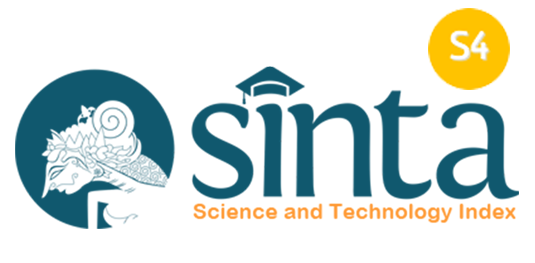Critical thinking of field dependent student’s in problem solving
Abstract
The purpose of this research is to describe the characteristics of the critical thinking of field-dependent cognitive style students in problem-solving. This research is qualitative research. Research subjects are students who have field-dependent cognitive style in class VIII SMP Negeri 1 Boyolangu, Indonesia. Data collection is GEFT test, math problem test, and interview. The results showed that strong field dependent students in mathematics problem solving aren't good at understanding the problem. At the implementing stage, the solution stage according to the previous plan. The problem-solving plan depends on the formulation of the problem that students found, students are less precise in carrying out the problem-solving. Students do not check again the answer. Critical thinking of weak field dependent students is not good in understanding the problem, and information in the problem is quite good. At the making solution plan stage, students do not write down what is known and asked and less able to express a solution plan clearly and logically with the problem. At the implementing stage, the solution plan is by the previous plan. The problem-solving plan depends on the problem formulation of the problem that students found, so students are less precise in carrying out the problem-solving. Students do not check again the answers.
Keywords
Full Text:
PDFReferences
Afifah, D. S. N. (2011). Pemahaman siswa SMA dalam memecahkan masalah matematika ditinjau dari perbedaan gaya kognitif (Unpublished thesis). Surabaya: Universitas Negeri Surabaya.
Albitz, R. S. (2007). The what and who of information literacy and critical thinking in higher education. Portal: Libraries and the Academy, 7(1), 97-109.
Chinien, C. A., & Boutin, F. (1993). Cognitive Style FD/I: An important learner characteristic for educational technologists. Journal of educational technology systems, 21(4), 303-311.
Emir, S. (2013). Contributing of teacher's thinking styles to critical thinking dispositions (Istanbul-Fatih sample). Educational Sciences: Theory & Practice., 13(1), 337–347.
Ennis, R. H. (1995). Critical thinking. New Jersey: Prentice-Hall.
Facione, P. A. (2011). Critical thinking: What it is and why it counts. Insight assessment, 2007(1), 1-23.
Facione, N. C., & Facione, P. A. (1996). Externalizing the critical thinking in knowledge development and clinical judgment. Nursing Outlook, 44(3), 129-136.
Fithriyah, I. ., Sa’dijah, C., & Sisworo. (2016). Analisis kemampuan berpikir kritis siswa Kelas IX-D SMPN 17 Malang. In Prosiding Konferensi Nasional Penelitian Matematika dan Pembelajarannya (pp. 580–590). Surakarta: Universitas Muhammadiyah Surakarta.
Halpern, D. F. (1998). Teaching critical thinking for transfer across domains: Disposition, skills, structure training, and metacognitive monitoring. American Psychologist, 53(4), 449–455.
Hendricson, W. D., Andrieu, S. C., Chadwick, D. G., Chmar, J. E., Cole, J. R., George, M. C., ... & Meyerowitz, C. (2006). Educational strategies associated with development of problem-solving, critical thinking, and self-directed learning. Journal of Dental Education, 70(9), 925-936.
Huang, H. F., Ricci, F. A., & Mnatsakanian, M. (2016). Mathematical teaching strategies: Pathways to critical thinking and metacognition. International Journal of Research in Education and Science, 2(1), 190-200.
Huang, L. Y., & Yeh, Y. C. (2017). Meaningful gamification for journalism students to enhance their critical thinking skills. International Journal of Game-Based Learning (IJGBL), 7(2), 47-62.
Hudha, M. N., & Batlolona, J. R. (2017). How are the physics critical thinking skills of the students taught by using inquiry-discovery through empirical and theorethical overview?. Eurasia Journal of Mathematics, Science and Technology Education, 14(2), 691-697.
Maandig, R. B., Lomibao, L. S., & Luna, C. A. (2017). Structured Content Reading Instruction vs. Direct Instruction: Their Implication on Students’ Achievement, Reading Comprehension and Critical Thinking in Mathematics. American Journal of Educational Research, 5(5), 574-578.
Mayer, R. E., & Massa, L. J. (2003). Three facets of visual and verbal learners: Cognitive ability, cognitive style, and learning preference. Journal of Educational Psychology, 95(4), 833–846.
Ngilawajan, D. A. (2013). Proses berpikir siswa SMA dalam memecahkan masalah matematika materi turunan ditinjau dari gaya kognitif field independent dan field dependent. Pedagogia, 2(1), 71–83.
Paradesa, R. (2016). Kemampuan berpikir kritis matematis mahasiswa melalui pendekatan konstruktivisme pada matakuliah matematika keuangan. Jurnal Pendidikan Matematika JPM RAFA, 1(2), 306–325.
Rasiman. (2015). Leveling of critical thinking abilities of students of mathematics education in mathematical problem. IndoMS-JME, 6(1), 40–52.
Riding, R. J., & Sadler‐Smith, E. (1997). Cognitive style and learning strategies: Some implications for training design. International Journal of training and Development, 1(3), 199-208.
Rifqiyana, L, M., & Susilo, B. E. (2016). Analisis Kemampuan berpikir kritis siswa Kelas VIII dengan pembelajaran Model 4K ditinjau dari gaya kognitif siswa. Unnes Journal of Mathematics Education, 5(1), 40–46.
Sadler-Smith, E., & Badger, B. (1998). Cognitive style, learning and innovation. Technology Analysis & Strategic Management, 10(2), 247-266.
Sadler-Smith, E., & Riding, R. (1999). Cognitive style and instructional preferences. Instructional science, 27(5), 355-371.
Siew, N. M., & Mapeala, R. (2016). The effects of problem-based learning with thinking maps on fifth graders’ science critical thinking. Journal of Baltic Science Education, 15(5), 602-616.
Tascón, L., Boccia, M., Piccardi, L., & Cimadevilla, J. M. (2017). Differences in spatial memory recognition due to cognitive style. Frontiers in pharmacology, 8, 550.
DOI: https://doi.org/10.18860/ijtlm.v1i1.5465
Refbacks
- There are currently no refbacks.
Copyright (c) 2020 International Journal on Teaching and Learning Mathematics

This work is licensed under a Creative Commons Attribution-NonCommercial-ShareAlike 4.0 International License.
Indexed by :
.png)
.jpg)
.png)

.jpg)



